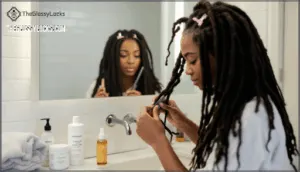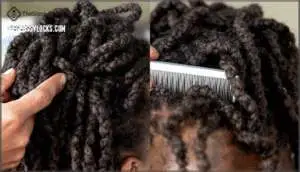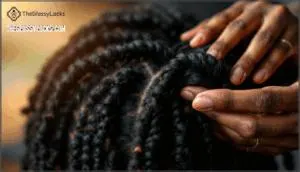This site is supported by our readers. We may earn a commission, at no cost to you, if you purchase through links.
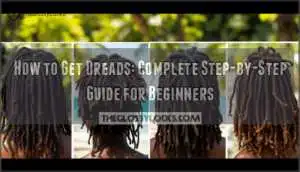
The journey starts with clean, sectioned hair and the right method for your specific hair type. Some people crochet their way to instant gratification, while others embrace the patience of freeform locs that mature over months.
Whether you’re drawn to the cultural roots, the low-maintenance appeal, or the bold statement dreads make, understanding the formation process sets you up for healthy, beautiful locks that reflect your personal style.
Table Of Contents
- Key Takeaways
- What Are Dreadlocks and Their Origins?
- How to Prepare Your Hair for Dreads
- Step-by-Step Methods to Start Dreadlocks
- Maintaining and Caring for Your Dreads
- Tips for Healthy, Stylish Dreadlocks
- Frequently Asked Questions (FAQs)
- How do you start dreads?
- How to get dreadlocks naturally?
- Can anyone start dreads?
- Can dreadlocks be undone?
- How long should my hair be for dreads?
- Can I get dreads with thin hair?
- Do I need special products for dreadlocks?
- Are dreadlocks sanitary?
- Can short hair be dreaded?
- Can you start dreads with short hair?
- Conclusion
Key Takeaways
- Dreadlocks form through deliberate techniques like backcombing, twisting, crochet, or freeform methods, with the best approach depending on your hair texture—Type 4 coily hair locks fastest in 6–12 months, while straight hair may take up to 36 months.
- Proper preparation is crucial: deep cleanse your hair to remove all buildup, section it carefully using tools like duck bill clips, and choose a starting method that matches your hair type and lifestyle commitment.
- Maintenance requires washing every 7–14 days with residue-free shampoo, retwisting every 4–8 weeks depending on maturity, and keeping your scalp moisturized with lightweight oils to prevent breakage and buildup.
- Your locs will progress through five distinct stages over 15–18 months—from starter coils through budding, teenage shrinkage, and finally mature locs—with each phase requiring patience and consistent care to achieve healthy, fully formed dreadlocks.
What Are Dreadlocks and Their Origins?
Dreadlocks aren’t just a hairstyle—they’re a journey with roots that stretch back thousands of years across multiple cultures. Understanding where locs come from and what they represent can help you appreciate the style you’re about to start.
Let’s look at the cultural history, how the style has changed over time, and what dreadlocks mean in today’s world.
Cultural and Historical Significance
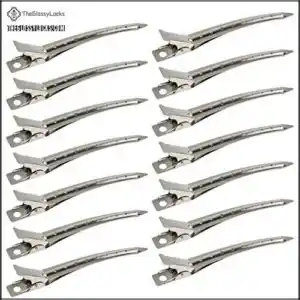 View On Amazon
View On Amazon - African and Rastafarian Symbolism – Among the Maasai, Himba, and Ashanti peoples, locs represent spiritual power and ancestral connection. Rastafarians adopted dreadlocks in the 1930s as symbols of resistance against oppression and pride in African identity.
- Social Identity and the Natural Hair Movement – During slavery, natural hair became a quiet defiance. By the 20th century, locs symbolized Black consciousness and self-determination, later reinforced by legislation like the CROWN Act addressing discrimination.
- Global Influence and Cultural Appropriation – While dreadlocks appeared in ancient Greece, Mesoamerica, and New Zealand, acknowledging their African and Rastafarian roots matters when getting dreadlocks today to honor their history authentically. Some evidence shows ancient Egyptians wore dreadlocks as early as 3100 BC.
Evolution of Dreadlocks Styles
Over centuries, dreadlocks transformed from ancient spiritual symbols into diverse expressions of identity. By the 1970s, Rastafari influence turned locs into icons of resistance through Bob Marley’s global reach. Counterculture impact followed—punk, grunge, and hip-hop communities embraced freeform and backcombed styles.
Today’s modern techniques include crochet hooks and interlocking for faster maturation, while fashion trends showcase micro locs, goddess locs, and colored variations. Understanding this history of dreadlocks helps you choose from different loc methods and anticipate stages of loc development ahead.
Dreadlocks have ancient origins in various cultures, including Vedic ascetics in India.
Locs in Modern Fashion and Identity
Today, locs show up everywhere—from Fashion runways to corporate offices—reflecting a major shift in workplace acceptance. Celebrity influence, especially from stars like Halle Bailey, fueled a 25% jump in dreadlocks product sales since 2023.
Yet Cultural appropriation debates persist, as less than 10% of profits reach Black-owned businesses.
Digital representation surged too, with loc hashtags hitting 2.3 billion views, proving natural hairstyles now drive both identity and mainstream hair style trends.
How to Prepare Your Hair for Dreads
Getting your hair ready for locs isn’t something you want to rush through. The prep work you do now will set the foundation for healthy, strong dreads that’ll last for years.
Let’s walk through what you need to do before you start forming those locs.
Assessing Your Hair Type and Texture
Your hair type and texture are like fingerprints—they determine how fast your locs will form and which method works best. Type 4 coily hair usually locks fastest (6–12 months) due to high friction between strands, while Type 1 straight hair may take 24–36 months.
Check your curl patterns, hair porosity using the float test, and density evaluation by counting strands in a small section. Natural hair with higher porosity and coarser texture generally mats more easily, giving you a head start on your loc journey.
Deep Cleansing and Conditioning
Before you start locking your hair, you need to strip away everything that might get in the way. Think of it as hitting the reset button—your hair needs to be completely clean, free from oils, products, and buildup that could prevent your locs from forming properly.
- Detox Frequency: Deep cleanse once or twice a year for mature locs, but skip this step if your hair is younger than six months
- Cleansing Agents: Use a clarifying shampoo like Neutrogena Anti-Residue or mix apple cider vinegar with baking soda for a DIY detox under $5
- Buildup Prevention: Avoid silicones and heavy thickeners in your shampoo—they trap residue inside locs and cause mildew
- Conditioning Role: Apply lightweight, residue-free conditioner every 2–3 weeks to reduce breakage without slowing loc maturation
- Post-Detox Care: Rinse thoroughly, dry with microfiber towels, and follow up with natural oils like jojoba within 48 hours to restore moisture
A deep conditioning treatment now sets the foundation for strong, healthy locs down the road.
Sectioning Hair for Loc Formation
Precision matters when you section your hair—it’s the blueprint for how your locs will sit, grow, and look. Hair sectioning techniques like brick-lay or fan patterns create a symmetrical appearance and prevent visible scalp gaps, while grid patterns keep things uniform but may show more scalp.
Use sectioning tools like rat-tail combs and clips to map out equal parts based on your hair density and head shape, guaranteeing balanced loc formation across all hair sections.
Essential Tools (e.g., Duck Bill Hair Styling Clips)
You’ll need the right gear before you twist a single strand—and quality clips are the unsung heroes of clean sectioning. Duck bill clips with sturdy grip strength keep hair sections firm during twisting without causing hair damage, while a crochet hook aids in weaving and tightening.
Skip flimsy clip material—nickel-plated metal resists rust and keeps edges smooth. A rat-tail comb, rubber band, and sectioning clips round out your toolkit for solid hair twisting control.
Step-by-Step Methods to Start Dreadlocks
Starting your dreadlock journey means choosing the right method for your hair and lifestyle.
There are several techniques to create locs, each offering different benefits depending on your hair texture and how you want your dreads to look.
Let’s walk through the most popular methods so you can find the one that fits you best.
Backcombing Method Explained
Think of backcombing as the fast track to fully-formed locs. You section your hair into squares, then comb each piece backward from tip to root using a fine-tooth comb, pushing strands toward your scalp to create tight knots.
This method works best on straight or wavy hair and delivers instant visual results—your dreads look mature right away. Just keep up with palmrolling maintenance every few weeks to prevent unraveling.
Twisting and Palm Rolling Techniques
Twisting and palm rolling are your go-to loc methods for tightly coiled hair, especially during the starter stage. With two-strand twists or comb coils, you’re building structure from the roots. Palm rolling pressure shapes each section between your palms, while consistent twist direction keeps everything uniform.
- Twist direction matters: Stick to clockwise or counterclockwise throughout every session to prevent unraveling
- Maintenance intervals: Retwist every 6–8 weeks for twisting, palm roll every 4–6 weeks
- Avoid root thinning: Don’t overtighten—this causes breakage in about 30% of DIY starters
- Watch for product buildup: Too much gel or wax slows maturation and attracts lint
- Accelerate locking: Consistent application shortens maturity time by roughly 25% in the first year
The Natural/Freeform Approach
Freeform locs allow your hair to lock naturally with minimal manipulation—no forced patterns, just your natural coiling doing the work. This approach honors cultural authenticity and simplifies your locs journey, especially during the starter stage. Scalp health remains strong when you wash every 1–2 weeks and avoid heavy products that slow loc formation.
Your hair texture determines the locking speed—tightly coiled types (4A–4C) lock fastest due to natural curl density. Just keep washing, let gravity and friction take care of the rest, and watch your unique pattern unfold.
| Timeline | What Happens |
|---|---|
| 0–3 months | Hair begins matting; starter stage coils form |
| 3–6 months | Budding stage; locs start sticking together |
| 6–12 months | Teen phase; defined shapes emerge |
| 12–24 months | Mature locs; firm, self-supporting structure |
Crochet and Interlocking Methods
Different dreadlock methods fast-track your locs journey when freeform feels too slow. The crochet hook pulls hair strands through themselves, weaving them into instant, mature-looking locs that work across 99% of hair types. Interlocking threads each loc through its root for a tight scalp grip but create visible bumps along the shaft.
Crochet advantages shine brightest when:
- Installation time matters—6 to 12 hours gives you smooth, cylindrical locs immediately
- Hair adaptability across textures (Asian hair needs 0.75–0.8 mm hooks; kinky textures lock tighter with 0.5 mm)
- Maintenance frequency stays manageable—retighten every 4 to 6 weeks for new growth
- Creating dreadlocks without waxes or gels that cause buildup
Hair sectioning techniques determine your final look. Interlock limitations include scalp tension and potential thinning—over-tightening damages hairlines fast, so spacing sessions 6 to 8 weeks apart protects your roots.
Choosing The Best Method for Your Hair
Your hair type dictates which method delivers the best results—Type 1 and 2 hair locks fastest with crochet or interlocking, while Type 3 and 4 textures thrive with two-strand twist, comb coils, or backcombing.
Lifestyle factors matter too: active schedules favor low-maintenance interlocking, while budget considerations might lean toward DIY palm rolling.
Match your desired look and hair texture to maintenance needs—tighter styles need monthly retwists, but freeform locs grow naturally with minimal upkeep.
Maintaining and Caring for Your Dreads
Getting your dreads started is just the beginning—keeping them healthy and looking good takes the right care routine. Your locs need attention at every stage, from washing correctly to managing frizz and keeping your scalp happy.
Here’s what you need to know to maintain strong, beautiful dreads that’ll last.
Washing and Drying Techniques
Keeping your locs clean is simpler than you might think. Wash them every 7–14 days with a residue-free shampoo—this prevents product buildup and mildew that can weigh your hair down. Massage the shampoo into your scalp, rinse thoroughly, and squeeze out excess water.
Proper drying methods matter: use a microfiber towel, then air dry or blow dry on low heat. Never sleep with damp dreads—mildew prevention starts with complete drying. Healthy scalp health depends on these hair washing techniques.
Scalp Health and Moisturizing
Your scalp thrives when balanced. Aim for daily 5–10 minute scalp massages to boost blood flow and strengthen roots. Apply lightweight hair oil like jojoba or coconut twice weekly to maintain microbiome balance and lock in hair moisture.
Drink at least 2 liters of water daily; hydration effects show up as reduced hair dryness and flaking. Avoid tight styles—tension reduction prevents up to 35% of breakage.
Pair this with your hair washing routine for best scalp health.
Managing Frizz and Buildup
Why do frizz and buildup show up? Frizz happens when your cuticles lift from moisture imbalance—curly hair gets hit harder since natural oils can’t coat each strand. Buildup comes from product residue, hard water minerals, and trapped sebum.
Prevention Tips: Wash every 7–10 days with residue-free shampoo, skip heavy waxes, and use lightweight, water-soluble hair products.
Care Methods include palm rolling to smooth loose strands and controlled moisturizing to keep hair moisture balanced.
Long-Term Maintenance means detox treatments every 90 days to restore scalp health and protect your locs.
Regular Retwisting and Professional Maintenance
As your locs settle into their routine, retwisting frequency becomes your rhythm—every 4 weeks early on, stretching to 8–12 weeks once they’re fully mature. Professional dreadlock stylists use retwisting techniques like palm rolling and comb-twisting to protect scalp health and prevent traction alopecia.
Loctician services run $60–$200 per session, and they catch thinning or buildup early. Between visits, lightweight hair oil application keeps follicles hydrated without clogging.
Product trends now favor residue-free locs hair care tips that support long-term dreadlock maintenance.
Tips for Healthy, Stylish Dreadlocks
You’ve put in the work to start your locs, and now it’s time to keep them looking their best. Your journey with dreadlocks comes with its own rhythm of growth stages, style possibilities, and occasional bumps in the road.
Let’s walk through the key things you need to know to keep your locs healthy, fresh, and uniquely yours.
Stages of Loc Development
Your locs journey unfolds through five distinct phases, each with its own personality. During the starter stage (3–6 months), you’ll use starter methods like coils or twists to establish your foundation.
Next comes the budding stage (6–12 months), where budding frizz and internal swelling signal real progress.
The teen stage (12–18 months) brings teenage shrinkage and looping as locs find their shape.
Around 15–18 months, the mature stage arrives with mature density and smoother definition.
Common Challenges and How to Overcome Them
You’ll face hurdles like Buildup Prevention, Moisture Balance, and Breakage Control along your dreadlocks journey. Thinning Roots affect up to 40% of loc wearers from tight styling, so ease up on tension during retwists. An Itchy Scalp usually means product residue—wash weekly with clarifying shampoo to restore hair health.
For hair breakage, skip heavy buns and aggressive crochet work. Mold develops when locs stay damp beyond 48 hours, so dry thoroughly with microfiber towels.
Proper hair care and hair maintenance prevent most issues before they start.
Styling and Decorating Ideas
Your locs deserve their own wardrobe of hair accessories—and the options exploded in 2025. Gender preferences shape styling trends: women favor high buns and twisted updos for weddings, while men lean toward mohawk locs.
Loc accessories like 14K gold cuffs and crystal beads blend cultural influences with material innovation. Try barrel twists, colored locs, or handmade extensions for hair styling that celebrates your individuality through hair braiding techniques and thoughtful hair maintenance.
Removing or Undoing Dreadlocks Safely
Ready to move on from your dreadlocks? Removing locs takes patience—expect eight to 20 hours for medium-length hair, depending on product buildup and how long you’ve worn them.
Soaking dreadlocks in conditioner for 30 minutes boosts hair elasticity and prevents damage. Work from tip to root with a rat-tail comb, keeping hair lubricated throughout.
Professional costs run $250 to $950, but DIY removal works if you take breaks and trim weakened ends afterward.
Frequently Asked Questions (FAQs)
How do you start dreads?
Want to start your locs journey but unsure which path to take? You can begin dreadlocks using starter loc methods like backcombing, twisting, or the freeform approach. Hair type suitability matters—some techniques work better for certain textures.
Starting locs at home through DIY locs is possible, though professional guidance guarantees proper initial loc size and starting loc length for your desired style.
How to get dreadlocks naturally?
The freeform method lets dreadlocks form on their own without twisting or products. You simply wash your hair and let it naturally knot and mat over time.
This locs journey requires patience, as the process can take months depending on your hair type.
Can anyone start dreads?
Think of it as an open door—anyone can walk through, but you’ll need to check what you’re bringing along. Yes, anyone can start dreads, but your hair type, hair texture, scalp conditions, commitment level, and lifestyle compatibility matter.
Different hair coil patterns form locs differently, so understanding your hair texture helps you choose the right method with cultural sensitivity.
Can dreadlocks be undone?
Yes, dreadlocks can be undone, but patience is required. Removing dreadlocks involves careful combing with conditioner to minimize damage.
Professional help guarantees safer hair regrowth and proper hair care during reversal. Assess potential damage beforehand.
How long should my hair be for dreads?
Your hair needs at least three inches to start dreadlocks, though some methods like backcombing work better with six inches or more. Hair length impacts which technique you’ll use—shorter hair limits your options, while longer strands give you flexibility.
Hair type and hair growth rate also matter, since different textures loc differently and mature at their own pace.
Can I get dreads with thin hair?
You can definitely get dreadlocks with thin hair, though your approach matters. Focus on scalp health, protective styling, and choosing smaller sections to create fuller-looking locs.
Select lightweight hair care products that won’t weigh down thin hair, and consider volume-boosting methods during the loc formation process to boost thickness as your hair grows naturally.
Do I need special products for dreadlocks?
No magic potion is required, but the right hair care products make the journey smoother. You’ll want a residue-free shampoo for buildup prevention, a lightweight hair oil for moisture retention and scalp health, and maybe a loc gel suited to your hair type—though product alternatives like aloe vera work too.
Are dreadlocks sanitary?
Absolutely—when you follow a proper hair care routine. Washing your locs every two to three weeks with residue-free shampoo prevents product buildup and keeps your scalp healthy.
The key is thorough drying after washing to avoid mildew risk and maintain clean, fresh-smelling dreads.
Can short hair be dreaded?
Yes, you can start locs with as little as three inches of hair. Minimum hair length depends on your starter loc methods—backcombing and two-strand twist work well for short hair.
Hair texture matters, but most types can form locs. Maintaining short locs requires patience during the budding stage.
Can you start dreads with short hair?
You can start locs with hair as short as 3 inches using methods like backcombing or braids. Hair texture affects your starting methods and maintenance tips, but short hair works well for dreadlocks when you choose the right styling options.
Conclusion
Studies show that locs can take 6 months to 2 years to fully mature, depending on your hair type and chosen method. That timeline might feel intimidating at first, but remember—you’re not just learning how to get dreads, you’re starting a journey that’s uniquely yours.
Each phase brings new texture, personality, and strength to your locks. Embrace the process with patience, care for your scalp like it matters, and trust that your dreads will become exactly what you envisioned. Your transformation has already begun.

